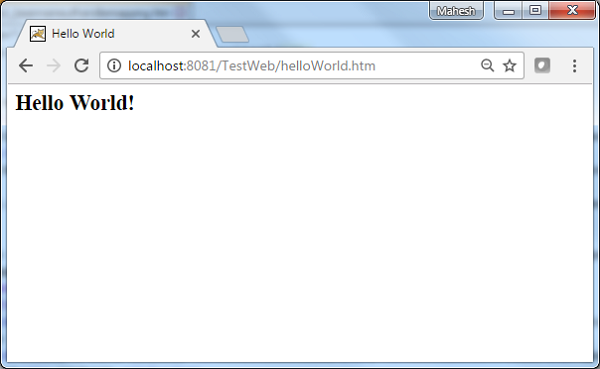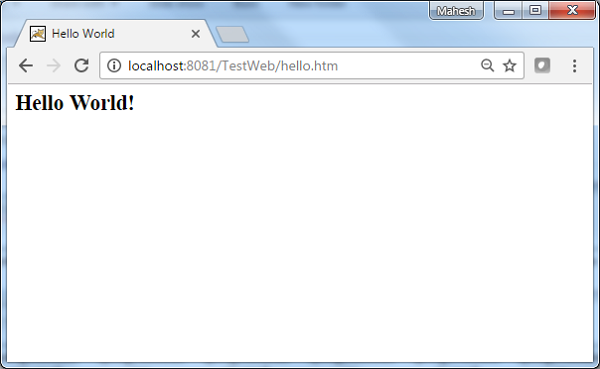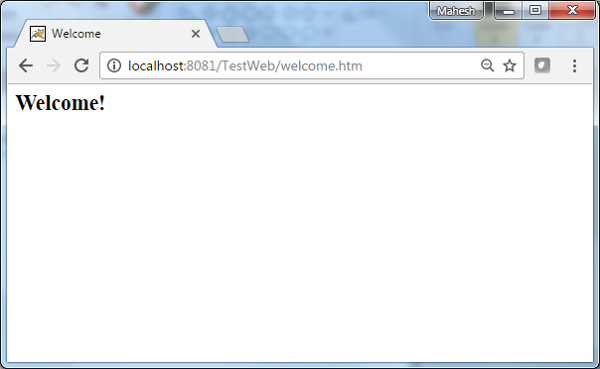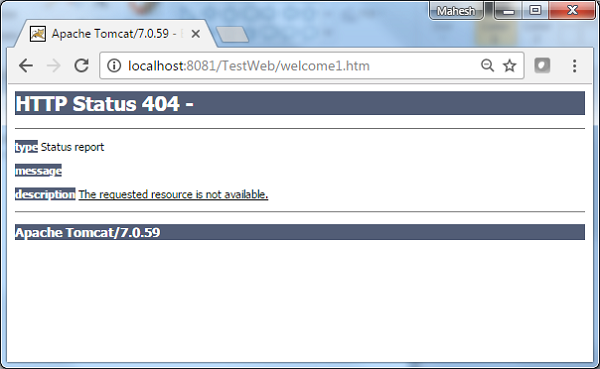The following example show how to use Bean Name Url Handler Mapping
using Spring Web MVC framework.
BeanNameUrlHandlerMapping class is the default handler mapping class
which maps URL request(s) to the name of the beans mentioned in the
configuration.
HelloController.java
Now start your Tomcat server and make sure you are able to access other web pages from webapps folder using a standard browser. Now try a URL http://localhost:8080/TestWeb/helloWorld.htm and you should see the following result if everything is fine with your Spring Web Application:
 Try a URL http://localhost:8080/TestWeb/hello.htm and you should see the following result if everything is fine with your Spring Web Application:
Try a URL http://localhost:8080/TestWeb/hello.htm and you should see the following result if everything is fine with your Spring Web Application:
 Try a URL http://localhost:8080/TestWeb/welcome.htm and you should see the following result if everything is fine with your Spring Web Application:
Try a URL http://localhost:8080/TestWeb/welcome.htm and you should see the following result if everything is fine with your Spring Web Application:
 Try a URL http://localhost:8080/TestWeb/welcome1.htm and you should see the following result if everything is fine with your Spring Web Application:
Try a URL http://localhost:8080/TestWeb/welcome1.htm and you should see the following result if everything is fine with your Spring Web Application:

<beans> <bean class="org.springframework.web.servlet.view.InternalResourceViewResolver"> <property name="prefix" value="/WEB-INF/jsp/"/> <property name="suffix" value=".jsp"/> </bean> <bean class="org.springframework.web.servlet.handler.BeanNameUrlHandlerMapping"/> <bean name="/helloWorld.htm" class="com.tutorialspoint.HelloController" /> <bean name="/hello*" class="com.tutorialspoint.HelloController" /> <bean name="/welcome.htm" class="com.tutorialspoint.WelcomeController"/> </beans>For example, using above configuration, if URI
- /helloWorld.htm or /hello{any letter}.htm is requested, DispatcherServlet will forward the request to the HelloController.
- /welcome.htm is requested, DispatcherServlet will forward the request to the WelcomeController.
- /welcome1.htm is requested, DispatcherServlet will not find any controller and server will throw 404 status error.
| Step | Description |
|---|---|
| 1 | Create a project with a name TestWeb under a package com.tutorialspoint as explained in the Spring MVC - Hello World Example chapter. |
| 2 | Create a Java classes HelloController, WelcomeController under the com.tutorialspoint package. |
| 3 | Create a view files hello.jsp, welcome.jsp under jsp sub-folder. |
| 4 | The final step is to create the content of all the source and configuration files and export the application as explained below. |
package com.tutorialspoint; import javax.servlet.http.HttpServletRequest; import javax.servlet.http.HttpServletResponse; import org.springframework.web.servlet.ModelAndView; import org.springframework.web.servlet.mvc.AbstractController; public class HelloController extends AbstractController{ @Override protected ModelAndView handleRequestInternal(HttpServletRequest request, HttpServletResponse response) throws Exception { ModelAndView model = new ModelAndView("hello"); model.addObject("message", "Hello World!"); return model; } }WelcomeController.java
package com.tutorialspoint; import javax.servlet.http.HttpServletRequest; import javax.servlet.http.HttpServletResponse; import org.springframework.web.servlet.ModelAndView; import org.springframework.web.servlet.mvc.AbstractController; public class WelcomeController extends AbstractController{ @Override protected ModelAndView handleRequestInternal(HttpServletRequest request, HttpServletResponse response) throws Exception { ModelAndView model = new ModelAndView("welcome"); model.addObject("message", "Welcome!"); return model; } }TestWeb-servlet.xml
<beans xmlns="http://www.springframework.org/schema/beans" xmlns:context="http://www.springframework.org/schema/context" xmlns:xsi="http://www.w3.org/2001/XMLSchema-instance" xsi:schemaLocation=" http://www.springframework.org/schema/beans http://www.springframework.org/schema/beans/spring-beans-3.0.xsd http://www.springframework.org/schema/context http://www.springframework.org/schema/context/spring-context-3.0.xsd"> <bean class="org.springframework.web.servlet.view.InternalResourceViewResolver"> <property name="prefix" value="/WEB-INF/jsp/"/> <property name="suffix" value=".jsp"/> </bean> <bean class="org.springframework.web.servlet.handler.BeanNameUrlHandlerMapping"/> <bean name="/helloWorld.htm" class="com.tutorialspoint.HelloController" /> <bean name="/hello*" class="com.tutorialspoint.HelloController" /> <bean name="/welcome.htm" class="com.tutorialspoint.WelcomeController"/> </beans>hello.jsp
<%@ page contentType="text/html; charset=UTF-8" %> <html> <head> <title>Hello World</title> </head> <body> <h2>${message}</h2> </body> </html>welcome.jsp
<%@ page contentType="text/html; charset=UTF-8" %> <html> <head> <title>Welcome</title> </head> <body> <h2>${message}</h2> </body> </html>Once you are done with creating source and configuration files, export your application. Right click on your application and use Export > WAR File option and save your TestWeb.war file in Tomcat's webapps folder.
Now start your Tomcat server and make sure you are able to access other web pages from webapps folder using a standard browser. Now try a URL http://localhost:8080/TestWeb/helloWorld.htm and you should see the following result if everything is fine with your Spring Web Application:
 Try a URL http://localhost:8080/TestWeb/hello.htm and you should see the following result if everything is fine with your Spring Web Application:
Try a URL http://localhost:8080/TestWeb/hello.htm and you should see the following result if everything is fine with your Spring Web Application: Try a URL http://localhost:8080/TestWeb/welcome.htm and you should see the following result if everything is fine with your Spring Web Application:
Try a URL http://localhost:8080/TestWeb/welcome.htm and you should see the following result if everything is fine with your Spring Web Application: Try a URL http://localhost:8080/TestWeb/welcome1.htm and you should see the following result if everything is fine with your Spring Web Application:
Try a URL http://localhost:8080/TestWeb/welcome1.htm and you should see the following result if everything is fine with your Spring Web Application:

No comments:
Post a Comment